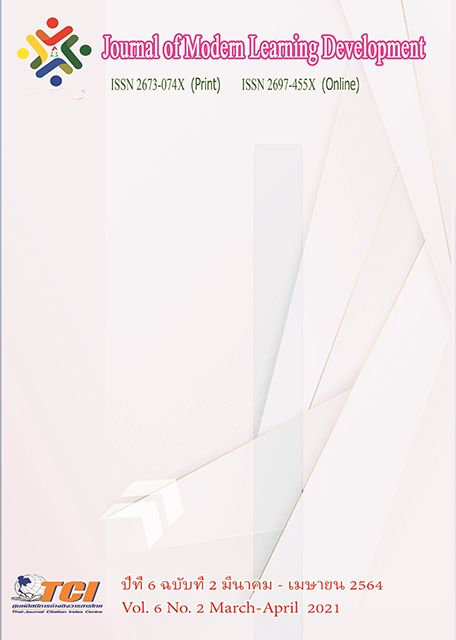Develop a Fostering Multicultural Competence through Literary Circles for Undergraduate Students
Main Article Content
บทคัดย่อ
The objective this study aimed to, 1) study the effectiveness of literary cycle activities in the development of multicultural competence, 2) study the opinions of students on the use of literary cycle activities to enhance multicultural competence. The sample consisted of 60 second-year English major students of the Faculty of Education, Uttaradit Rajabhat University. The sample was selected by purposive sampling. The students were enrolled in Children’s Literature course during their second academic year of 2019. The instruments used for this study were: twenty lesson plans; multicultural competence self-evaluation test; literature response journals; interview form; and classroom observation form. A t-test was used to compare the multicultural competence’s score of the two groups students. The classroom observation, in-depth interview, and literature response journal were interpreted and transcribed in order to gather the information by using content analysis. The results of the study were discussed into 2 parts; quantitative and qualitative data analysis. The quantitative data analysis was done using t-test by comparing multicultural competence of the experimental group students learned with the control group students. The results of the multicultural competence scores of the experimental group students with the control group students were significantly different at the level of .05. The qualitative data analysis was done by the students’ opinions towards the use of literature circle activities. The results found that students exactly knew what is literature circle and how it does. They also increased their cultural knowledge when using literature circle activities in their classroom.
Article Details
เอกสารอ้างอิง
Anurit, T. (2016). Implementation of literature circles to enhance Thai EFL learners’ critical thinking skills. PasaaParitat Journal, 31, 81-106.
Balone, E. (2015). Effects of the literature circle strategy on participation of English language learners [Unpublished master thesis]. University of New York.
Bedel, O. (2016). Collaborative learning through literature circles in EFL. European Journal of Language and Literature Studies, 6 (1), 96-99.
Campinha-Bacote, J. (1995). The quest for cultural competence in nursing care. Nursing Forum, 30 (4), 19-25
Calvillo, E., et al. (2009). Cultural competency in baccalaureate nursing education. Journal of Transcultural Nursing. 20 (2), 137-145.
Calzada, E. (2014). Enhancing Cultural Competence in Social Service Agencies: A Promising Approach to Serving Diverse Children and Families. The Office of Planning, Research & Evaluation www.acf.hhs.gov/opre.
Carrison, C., Ernst-Slavit, G. (2005). From silence to a whisper to active participation: Using literature circles with ELL students. Reading Horizon, 46 (2), 93-113.
Choudhury, M. (2013). Teaching Culture in EFL: Implications, Challenges and Strategies. IOSR Journal of Humanities And Social Science. 13. 20-24. 1
Clarke, L. W., Holwadel, J. (2007). “Help! What is wrong with these literature circles and how can we fix them?” The Reading Teacher, 61 (11), 20-29.
Creswell, J. W., & Plano Clark, V. L. (2011). Designing and conducting mixed methods research. (2nd ed.). Thousand Oaks, CA: Sage Publications,
Daniels, H. (2002). Literature circles: Voice and choice in book clubs and reading groups. (2nd ed). Portland, ME: Stenhouse.
De Leon-Siantz, M.L., Meleis, A. (2007). Integrating cultural competence into nursing education and practice: 21st century action steps. Journal of Transcultural Nursing 18 (Suppl. 1), 86S-90S.
Giger, J.N., Davidhizar, R.E. (2007). Transcultural Nursing, Assessment and Intervention. (5th ed). Mosby Elsevier, St Louis, Missouri.
Graham-Marr, A. (2015). Elevating the development of listening skills to foster SLA in an Asian context. Journal of Foreign Language Teaching and Applied Linguistics, 2 (2), 1-6.
Johnson, R., Onwuegbuzie, A. J. (2004). Mixed-methods research: A research paradigm whose time has come. Educational Researcher, 33 (7), 14-26.
Long, T.W. , Gove, M. K. (2003) . How engagement strategies and literature circles promote critical response in a fourth-grade urban classroom. The Reading Teacher, 57 (4), 350-360.
Nida, E. (2007). Translation and culture. In Fuertes, P.A. (Coord.). Problemas lingüísticos en la traducción especializada. Valladolid: Universidad de Valladolid.
Reisinger, Y. (2009). International Tourism: Cultures and Behavior . USA. Elsevier.
Schwebs, R. B. (2019). Use of Literature Circles to Promote Cultural Knowledge and Oral Communication Exploring the issues of apartheid and human rights through literature circles. Master’s Thesis. Western Norway University of Applied Sciences.
Tashakkori, A., & Teddlie, C. (Eds.). (2003). Handbook of mixed methods in social & behavioral research. Thousand Oaks, CA: Sage.
Weaver, H.N. (1999). Indigenous people and the social work profession: Defining culturally competent services. Social Work, 44 (3), 217-225.


